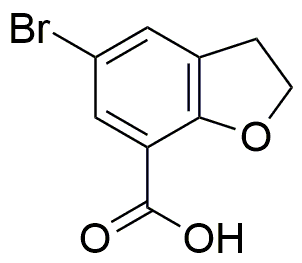5-Bromo-2,3-dihydrobenzofuran-7-carboxylic acid is widely utilized in research focused on:
- Synthetic Organic Chemistry: This compound serves as a versatile building block in the synthesis of various complex organic molecules, making it valuable for researchers developing new pharmaceuticals.
- Pharmaceutical Development: Its unique structure allows for the exploration of new drug candidates, particularly in the treatment of neurological disorders, where modifications can enhance efficacy and reduce side effects.
- Material Science: The compound can be used in the development of advanced materials, such as polymers and coatings, that require specific chemical properties for improved performance.
- Biological Research: It is employed in studies investigating the biological activity of related compounds, helping researchers understand mechanisms of action and potential therapeutic effects.
- Environmental Chemistry: The compound's properties make it suitable for research into environmental pollutants, aiding in the development of methods to detect and remediate harmful substances in ecosystems.
Informations générales
Propriétés
Sécurité et réglementation
Applications
5-Bromo-2,3-dihydrobenzofuran-7-carboxylic acid is widely utilized in research focused on:
- Synthetic Organic Chemistry: This compound serves as a versatile building block in the synthesis of various complex organic molecules, making it valuable for researchers developing new pharmaceuticals.
- Pharmaceutical Development: Its unique structure allows for the exploration of new drug candidates, particularly in the treatment of neurological disorders, where modifications can enhance efficacy and reduce side effects.
- Material Science: The compound can be used in the development of advanced materials, such as polymers and coatings, that require specific chemical properties for improved performance.
- Biological Research: It is employed in studies investigating the biological activity of related compounds, helping researchers understand mechanisms of action and potential therapeutic effects.
- Environmental Chemistry: The compound's properties make it suitable for research into environmental pollutants, aiding in the development of methods to detect and remediate harmful substances in ecosystems.
Documents
Fiches de données de sécurité (FDS)
La FDS fournit des informations de sécurité complètes sur la manipulation, le stockage et l’élimination du produit.
Spécifications du produit (PS)
Le PS fournit une description complète des propriétés du produit, notamment sa composition chimique, son état physique, sa pureté et les exigences de stockage. Il détaille également les plages de qualité acceptables et les applications prévues du produit.
Certificats d'analyse (COA)
Recherchez des certificats d'analyse (COA) en saisissant le numéro de lot du produit. Les numéros de lot et de lot se trouvent sur l'étiquette d'un produit, après les mots « Lot » ou « Lot de fabrication ».
Numéro de catalogue
Numéro de lot/série
Certificats d'origine (COO)
Ce certificat d'exploitation confirme le pays dans lequel le produit a été fabriqué, et détaille également les matériaux et composants utilisés et s'il est issu de sources naturelles, synthétiques ou autres sources spécifiques. Ce certificat peut être requis pour les douanes, le commerce et la conformité réglementaire.
Numéro de catalogue
Numéro de lot/série
Fiches de données de sécurité (FDS)
La FDS fournit des informations de sécurité complètes sur la manipulation, le stockage et l’élimination du produit.
DownloadSpécifications du produit (PS)
Le PS fournit une description complète des propriétés du produit, notamment sa composition chimique, son état physique, sa pureté et les exigences de stockage. Il détaille également les plages de qualité acceptables et les applications prévues du produit.
DownloadCertificats d'analyse (COA)
Recherchez des certificats d'analyse (COA) en saisissant le numéro de lot du produit. Les numéros de lot et de lot se trouvent sur l'étiquette d'un produit, après les mots « Lot » ou « Lot de fabrication ».
Numéro de catalogue
Numéro de lot/série
Certificats d'origine (COO)
Ce certificat d'exploitation confirme le pays dans lequel le produit a été fabriqué, et détaille également les matériaux et composants utilisés et s'il est issu de sources naturelles, synthétiques ou autres sources spécifiques. Ce certificat peut être requis pour les douanes, le commerce et la conformité réglementaire.


